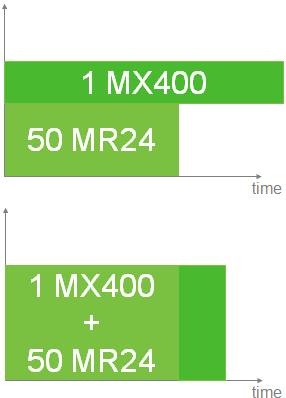Description
Meraki MX60 Advanced Security License and Support, 7YR
Overview
The Meraki MX is a multi-functional security & SD-WAN enterprise appliance with a wide set of capabilities to address multiple use cases for organizations of all sizes, in all industries.
Given the range of use cases that can be solved, there are three license options for the MX appliance that provides customers the flexibility to select the license most appropriate for their intended use.
| Enterprise | Advanced Security | Secure SD-WAN Plus |
| “All I require is Auto VPN and a firewall” | “I connect directly to the Internet so need a UTM too” | “My business is reliant on SaaS/IaaS/DC served apps” |
|
|
|
The Meraki MX Advanced Security Support and License brings the benefits of cloud based centralized management to the powerful Meraki MX security appliance platform. In addition to unlimited client VPN access, content filtering, anti-virus/phishing engine, feature upgrades and 8×5 live enterprise support, Meraki’s Dashboard cloud provides real-time connectivity, VPN tunnel and WAN optimization monitoring, end-client discovery and fingerprinting, and alerting tools to notify administrators of downtime and configuration changes. Each Meraki MX device is automatically provisioned from the cloud, radically simplifying large-scale distributed deployments. Rich web-based diagnostics let you troubleshoot, manage and secure your networks from any web browser.
Meraki devices use the Meraki cloud for centralized management and control. The Meraki cloud is licensed on a “per device, per year” basis. Each organization is licensed for a certain number of devices through a termination date.
Licenses are sold separately from the hardware. For example, you could upgrade from the MR16 to the MR24 without buying new licenses. The same will apply for new products that are released in the future.
In general, all Meraki products follow the same licensing model. The primary difference between them is that with all wireless access points (MR series) the license is the same for all hardware models, whereas with the switches (MS series) and security appliance line (MX series) each hardware model has a different license. Example: the LIC-ENT-1YR (1 year enterprise MR license) applies to any of the MR access points. The LIC-MS220-24-1YR (1 year enterprise MS220-24 license) applies to the MS220-24 model. The LIC-ENT-MX64-1YR (1 year enterprise MX64 license) applies to the MX64.
Features
- Subscription license (1-10 years)
- 1 firewall
- hosted
Highlights
- Cloud-based centralized management, eliminates on-site hardware controller
- Network-wide visibility and control
- Massively scalable, up to 10,000 APs
- Out-of-band control plane: network traffic does not pass through cloud, network stays up if connection to cloud is lost
- Powerful multi-site management tools
- Automatic RF optimization, network monitoring and alerts
- Seamless firmware and security updates
- Intuitive browser-based dashboard eliminates training and dedicated staff
The licensing structure for MX appliances is the same as that of any other Meraki device – 1:1 ratio of devices to licenses. Pair your chosen MX appliance(s) with the relevant license for your use case
Meraki currently offers two types of licensing models: a new, per-device licensing (PDL) model and a co-termination licensing model (co-term). There are important differences between the two models to consider when deciding which model is best for you.
As of November 2019, all Meraki customers are currently using a co-term licensing model by default. Per-device licensing is available for all new and existing customers to opt into. If you are a new customer creating a new Meraki organization, you will automatically default to the co-term licensing model. If you wish to be on per-device licensing, you can opt in via the Meraki dashboard after creating your organization.
Meraki Per-Device Licensing
Per-device licensing offers a variety of new features and enhanced flexibility for new and existing customers of all sizes:
-
License devices individually: Assign a license to a specific device (MR, MS, MX, MV, MG) or a network (in the case of vMX and SM licenses) and maintain a shared expiration date or separate expiration dates across devices, networks, or organizations.
-
Partial renewals: Enjoy the ability to renew all your devices or a subset of devices, as you prefer.
-
Move licenses between orgs: Org admin (read/write) on multiple organizations are able to move a license (or licenses and devices together) between those organizations without calling into Meraki support. This functionality is available through the dashboard and APIs.
-
90-day license activation window: You will have up to 90 days to claim and assign your licenses before they activate, giving you more time to deploy Meraki products before your licenses burn time.
-
APIs: APIs are available to claim, assign, and move licenses. This will allow a greater level of automation and the ability to integrate with other systems.
-
Individual device shutdowns: If a license expires on a device, Meraki will only shut down that device or product after the 30 grace period.
This licensing model is especially useful for coordinating licensing across different sites or organizations when those sites (and associated devices) are budgeted or accounted for in different ways. It can also be beneficial to use when adding new hardware or expanding your Meraki infrastructure by allowing you to intuitively rationalize expiration dates for new and existing devices.
For more information and instructions on converting to this licensing model, refer to the Meraki Per-Device Licensing Overview documentation.
Meraki Co-Term Licensing
Meraki co-term licensing is applied on an organization-wide basis, resulting in a single expiration date for every Meraki device managed in an organization. That date is dynamically calculated based on a weighted average of the license types purchased and claimed into your dashboard organization. This is accomplished by averaging all active licenses together and dividing by the license limit, or allowed count of Meraki devices in the organization. The single expiration date for all Meraki devices in that organization is dynamically recalculated (by the Meraki dashboard) with each license and hardware claim.

For example, suppose an organization had two separate Enterprise AP licenses, one license for 2x APs spanning one year (365 days) and another for 1x AP spanning five years (1,825 days). The co-termination value would be calculated as ((1825*1)+(365*2))/3= 851 days total for all three APs. So assuming all three licenses were applied on the same day, the organization would have a co-term date of 851 days from the start date of the licenses.
Licensing Model Similarities
-
Customers are able to maintain a shared expiration date across all of their devices/products within an organization in both licensing models
-
All Meraki core products function in both models. Some additional products (such as Meraki wireless with Umbrella) are only offered on the per-device licensing model
-
Customers purchase licenses for both models in the same way (i.e. the same SKU)
-
The price of licenses remains the same between the two models
-
Customers receive a single license key and order number in each model
-
MX devices must have organization-wide Advanced Security or Enterprise Security licensing in both licensing models
 Firewall Training in India Cyber Security Training & Firewall Training Provider in India
Firewall Training in India Cyber Security Training & Firewall Training Provider in India














